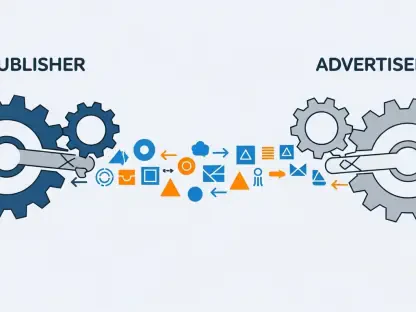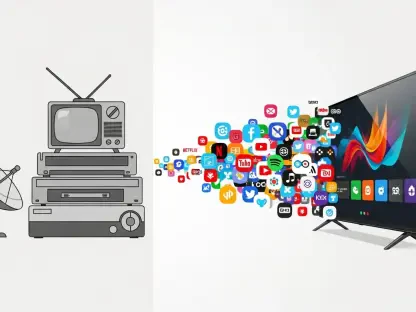The telecommunications industry has been experiencing a significant digital transformation primarily driven by the rise and necessity of unified commerce. Companies within the sector are beginning to recognize the inherent value unified commerce brings, but many still face considerable challenges due to outdated systems and fragmented customer experiences. Industry experts, including Matt Alberts, Vice President of Global Solutions Consulting at commercetools, have highlighted both the hurdles and opportunities that lie ahead for telecommunications companies as they strive to achieve a seamless omnichannel experience.
Industry Evolution
Retail Industry Benchmark
Traditional retail has long prioritized omnichannel strategies, focusing on providing seamless customer experiences across multiple channels since the early 2000s. These companies recognized early that consumers were seeking more integrated and comprehensive shopping experiences, prompting them to innovate and enhance their offerings. Retailers invested heavily in technology to ensure that customers could enjoy a consistent and cohesive journey, whether they were shopping online, in-store, or through mobile applications. This investment has paid off, as successful omnichannel integration has become a crucial competitive advantage and contributed to increased customer loyalty and satisfaction.
The success of the retail sector’s omnichannel strategy sets a benchmark for other industries, including telecoms. It has demonstrated that integrating various sales and service channels into a seamless platform can significantly enhance the customer experience and streamline operations. Retailers’ experience serves as a valuable case study in the necessity and effectiveness of a unified approach, offering telecommunications companies a roadmap for their own transformation. By examining the retail industry’s journey, telecoms can better understand the steps needed to overcome the challenges they face and leverage the benefits of unified commerce.
Telecom’s Late Start
Despite the clear advantages evident in the retail sector, the telecommunications industry has traditionally lagged behind in adopting omnichannel solutions. Telecommunications companies only began to feel the pressing need for such strategies about a decade later, primarily due to competitive pressures from innovative tech companies like Apple. These tech giants set a new standard in customer experience, offering seamless service across various platforms and channels. This competition compelled telcos to reconsider their customer engagement approaches and begin the shift toward more integrated solutions.
The late start has meant that telecoms are now playing catch-up in an environment where customer expectations are higher than ever. Clients accustomed to the seamless experiences provided by tech and retail companies expect the same from their telecommunications providers. This shift in expectation has made it imperative for telecom companies to modernize their systems and adopt a unified commerce approach. The delay in this transformation has resulted in significant discrepancies in service quality and customer satisfaction, emphasizing the need for an accelerated adoption of these strategies.
Challenges Faced by Telcos
Outdated Systems
One of the primary challenges faced by telecommunications companies is the reliance on outdated systems. Many telcos are currently operating with core commerce and point-of-sale (POS) systems purchased 10-15 years ago. These systems, although reliable during their initial years, have become heavily customized to meet varying business needs over time. Such extensive customization has created significant barriers to updates and integration, making it challenging for telcos to modernize their infrastructure. The highly tailored nature of these legacy systems means that any attempt to upgrade or integrate new capabilities often requires substantial time and resources.
These outdated systems are not only inefficient but also limit the ability of telcos to provide a seamless customer experience. The integration of advanced features and functionalities becomes increasingly difficult, leading to slower service delivery and fragmented customer interactions. As the industry evolves, the inability to swiftly adapt and integrate new technologies places telcos at a disadvantage, hindering their competitiveness and customer satisfaction levels. The need to transition to more flexible and integrative systems has become a pressing concern for the telecommunications sector.
Fragmented Customer Experience
Another significant challenge for telcos lies in the fragmented customer experience resulting from disparate legacy systems. The customer service landscape for many telecommunications companies is characterized by silos, with online platforms, call centers, corporate stores, and franchise stores operating independently. This siloed approach leads to inconsistencies in service and customer interactions, as each channel may have different systems, pricing, promotions, and inventory details. Such fragmentation makes it difficult for customers to have a cohesive and consistent experience, regardless of the channel they choose.
The disjointed nature of these interactions often results in customer frustration and dissatisfaction. For instance, a promotion visible online may not be available in a corporate store, or inventory information may differ between channels, creating confusion and a lack of trust among customers. The inability to resolve issues seamlessly across different channels further exacerbates the problem, as support teams may only have visibility and control over their specific domains. This fragmentation underscores the urgent need for a unified commerce system that can synchronize and streamline the customer journey, ensuring a consistent and satisfying experience across all touchpoints.
The Resource-Intensive Issue
Customization Struggles
The struggle to add modern omnichannel capabilities to outdated systems is another crucial issue that telcos face. Customizing legacy systems to include new features that support a seamless omnichannel experience is often a resource-intensive and inefficient endeavor. The time, effort, and financial investment required to make these modifications can be substantial. Moreover, the heavily customized nature of these systems means that introducing new functionalities can lead to unforeseen complications and technical debt, further complicating the upgrade process.
Resource-intensive customization efforts can detract from other strategic initiatives, slowing down overall progress and innovation within the company. As telecommunications companies invest heavily in trying to modify their existing systems, they may fall behind competitors who leverage more modern and flexible technology solutions. This scenario creates a vicious cycle where resources are continuously drained without achieving the desired outcomes, highlighting the need for a shift to more adaptable and integrated systems that can support future growth and technological advancements.
Disjointed Interactions
Inconsistencies in customer interactions across various channels present a significant challenge for maintaining a cohesive brand experience. Customers often encounter disparate pricing, promotions, and inventory availability across different sales and service channels due to the fragmented nature of telco systems. This lack of integration not only frustrates customers but also undermines their trust in the brand. When customers perceive that they are receiving varying information or deals depending on the channel used, it can lead to diminished satisfaction and loyalty.
The inability to provide a unified, omnichannel experience means that customers cannot seamlessly transition between different service touchpoints. For instance, a customer starting a purchase online may struggle to complete the transaction in-store due to mismatched inventory or promotional details. Additionally, customer support issues resolved in one channel may not be visible to representatives in another, causing redundant questionings and prolonging resolution times. These disjointed interactions highlight the necessity for telecoms to adopt an integrated approach that ensures consistent and smooth experiences across all platforms and channels.
Unified Commerce to the Rescue
Integration Benefits
Unified commerce serves as a transformative solution for the telecommunications industry, integrating disparate systems into a single backend platform and eliminating data silos. This integration ensures that all customer-related data, processes, and services are harmonized, fostering consistency across different touchpoints. By consolidating various systems into one cohesive platform, telcos can achieve greater visibility and control over their operations, enabling them to provide a more uniform and reliable customer experience.
The benefits of this integration are manifold. A single backend platform allows for the creation and deployment of promotions, pricing, and inventory details just once, which can then be disseminated across all channels. This approach streamlines operations, reducing redundancy and increasing efficiency. It also enables telcos to respond more swiftly to market changes and customer needs, ensuring they remain competitive. The elimination of data silos means that customer interactions are tracked and managed cohesively, preventing fragmented experiences common with legacy systems. Overall, unified commerce facilitates a more agile and responsive business model.
Efficiency Enhancements
Adopting a unified commerce approach not only improves customer experience but also significantly enhances operational efficiency. By unifying various sales and service channels, telecommunications companies can eliminate redundant processes and streamline their operations. This efficiency gain is achieved through the centralized management of promotions, pricing, and inventory, which allows for faster and more accurate dissemination of information across all channels. As a result, telcos can reduce the time and resources spent on maintaining and updating multiple systems, freeing up capacity for innovation and strategic initiatives.
Moreover, efficiency enhancements drive cost savings by reducing the need for extensive customization and maintenance of legacy systems. Unified commerce platforms are designed to be more adaptable and easier to manage, enabling telecoms to implement new features and capabilities with minimal disruption. This flexibility also allows companies to scale their operations more effectively, accommodating growth and evolving market demands. Ultimately, the transition to a unified commerce model positions telecommunications companies to operate more efficiently, deliver better customer service, and maintain a competitive edge in an increasingly digital marketplace.
Enhanced Customer Experience
Consistency Across Channels
A key advantage of unified commerce is the ability to offer consistency across all customer interaction channels. Customers receive the same deals, promotions, and service experiences regardless of whether they engage online, in-store, or through other platforms. This consistency greatly enhances customer satisfaction and loyalty, as it creates a seamless and predictable experience. The ability to trust that the information received is accurate and uniform across channels builds confidence in the brand and encourages repeat business.
Consistency also extends to customer support and service. With unified commerce, customer interactions and histories are accessible across all channels, enabling support teams to provide informed and timely assistance. This integrated view ensures that issues resolved in one channel are visible in another, reducing redundancy and improving resolution times. The result is a more cohesive and satisfying customer journey, where transitions between different touchpoints are smooth and effortless. This seamless integration is essential for meeting modern customer expectations and fostering long-term loyalty.
Responding to Market Growth Plateau
As the telecommunications market approaches a growth plateau, differentiating through superior customer experiences becomes increasingly important. Unified commerce provides a strategic advantage by enabling telecoms to deliver exceptional service and engagement across all channels. This differentiation is crucial in a market where network reliability is no longer the sole competitive factor; customers now prioritize the overall experience surrounding purchases, upgrades, and plan management.
Unified commerce allows telcos to innovate and personalize their offerings, tailoring promotions and service packages to individual customer needs. This level of personalization is key to standing out in a crowded market and attracting and retaining customers. By leveraging a unified platform, telcos can quickly adapt to changing market conditions and customer preferences, ensuring they remain relevant and competitive. The ability to provide a seamless and highly engaging customer experience is not just a nice-to-have but a necessity in today’s telecommunications landscape.
Composable Systems Strategy
Breaking Down Monolithic Systems
There is a growing recognition within the telecommunications industry that breaking down monolithic systems in favor of a composable architecture is essential for agile and efficient operations. Monolithic systems, characterized by their rigid and all-encompassing design, pose significant challenges when it comes to adapting to new technologies and market demands. A composable architecture, by contrast, allows telcos to leverage best-in-class components for various functions, providing greater flexibility and scalability.
Breaking down monolithic systems involves dismantling the legacy infrastructure into smaller, more manageable modules that can be integrated and updated independently. This approach reduces the complexity and cost associated with system upgrades and maintenance, enabling telcos to innovate more freely and respond more quickly to changes. A composable architecture also facilitates easier integration of third-party solutions, allowing telecommunications companies to enhance their service offerings without extensive customizations. This strategic shift is crucial for telcos seeking to remain competitive and agile in a rapidly evolving market.
Leveraging Best-In-Class Components
Adopting a composable systems strategy enables telecommunications companies to leverage best-in-class components for various functions, significantly enhancing performance and operational efficiency. Instead of relying on a single, inflexible system, telcos can choose and integrate the most effective solutions available in the market. This approach allows for greater innovation and adaptability, as each component can be selected based on its specific strengths and capabilities. It also ensures that telcos can implement new technologies and features more quickly and effectively, staying ahead of the competition.
The use of best-in-class components also means that telecommunications companies do not need to replace their entire existing systems, which can be a costly and disruptive process. Instead, they can strategically reintegrate these components with their current infrastructure, ensuring a seamless transition without significant downtime. This modular approach provides a more sustainable and scalable path to modernization, enabling telcos to continuously improve their service offerings and customer experience. Ultimately, leveraging best-in-class components within a composable architecture positions telecommunications companies to thrive in an increasingly dynamic and competitive market.
Conclusion
The telecommunications industry is undergoing a major digital transformation driven by the rise of unified commerce. Companies within the sector are starting to see the inherent value of unified commerce, though many still grapple with outdated systems and fragmented customer experiences. Industry experts, like Matt Alberts, Vice President of Global Solutions Consulting at commercetools, have pointed out both the challenges and opportunities ahead for telecommunications firms. As these companies strive for a seamless omnichannel experience, they must upgrade their outdated systems, integrate new technologies, and ensure consistent customer interactions across all platforms. This transformation will not only improve customer satisfaction but also position these firms competitively in a digital-first marketplace. Companies that successfully navigate this shift will stand to gain significant advantages, enhancing their operational efficiency and customer loyalty in the evolving telecommunications landscape.









